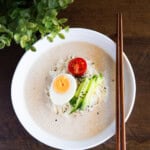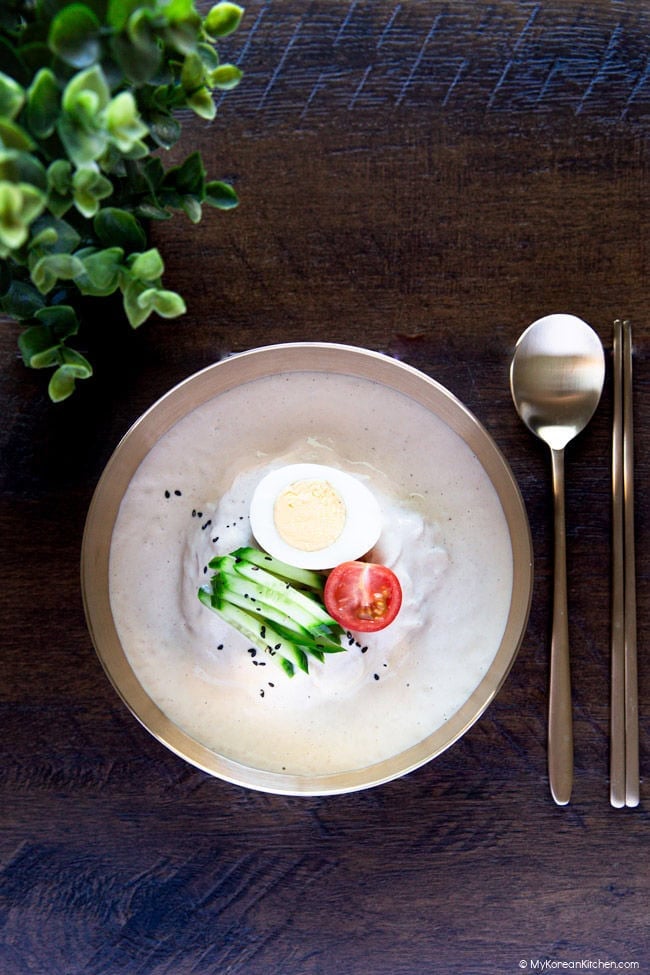
Why Make Kongguksu at Home

Tips for the Best Kongguksu
Soybeans and Alternatives
Consider using organic soybeans for your recipes. Interestingly, I had some trouble finding dried soybeans at my local Korean and non-Korean grocery stores. Fortunately, I was able to order them from Amazon, and they worked perfectly. For kongguksu, you’ll need to soak the soybeans overnight or for at least 8 hours to rehydrate them. However, if you use hot boiling water, 1 hour is sufficient.
If soybeans aren’t your thing, chickpeas are a good substitute, though they have a milder flavor. Personally, I prefer the taste of kongguksu made with soybeans. You can use either dried or canned chickpeas, both of which work well. Canned chickpeas are a great time-saver since they don’t need soaking.
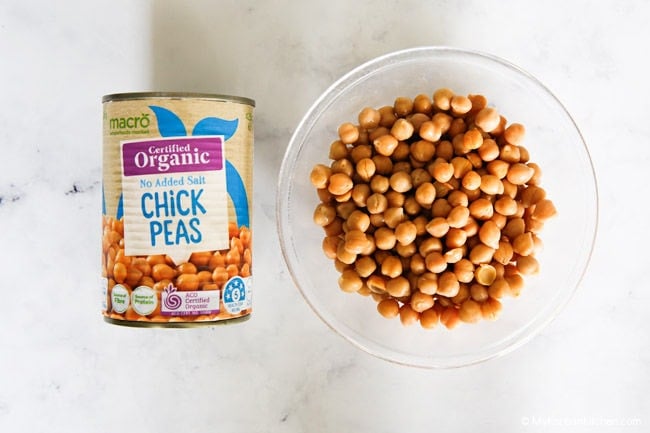
Alternatively, you can use soybean powder (konggaru, 콩가루) from a Korean grocer. Not all Korean grocers carry it, but when they do, it’s often ready to use for kongguksu and may include other ingredients like ground nuts and a bit of salt.
To prepare, mix and dissolve the powder in water or milk. Then, simply serve it over boiled thin wheat noodles like somen (somyeon, 소면) and top with your choice of toppings (see the suggestions in the ingredients section below). I find that using milk gives a richer, nuttier flavor than water, so I recommend it. However, the soybean powder has quite an intense nutty flavor on its own, so I don’t feel the need to use soy milk.
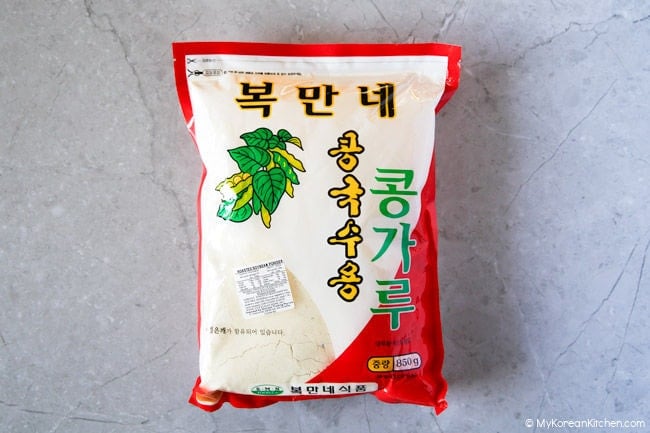
For the best results, use 1/2 cup of soybean powder with 1 cup of full cream milk and 1/4 teaspoon of fine sea salt. Even though the soybean powder already contains salt, you’ll hardly notice it once the noodles are added, so you might want to sprinkle in a little extra.
Soy Milk and Alternatives
There are a couple of ways to make the soup for this recipe, and I think organic soy milk works best when using actual soybeans for a deeper flavor. However, if you don’t have soy milk or prefer not to use it, you can use the water from boiling soybeans or regular milk instead. Just keep in mind that these alternatives won’t be as rich and flavorful as the soy milk version and may give your soup a less appealing look.

Ingredients for Kongguksu
- 1/2 cup organic dried soybeans (or dried chickpeas, or one 425g can of chickpeas)
- 5 cups water
- 3/4 tsp fine sea salt, divided (1/4 tsp for boiling + 1/2 tsp for blending)
- 1 Tbsp sesame seeds
- 1 Tbsp pine nuts
- 1 Tbsp walnuts
- 200g / 7.1 ounces somen noodles (thin wheat noodles)
- 2 cup unsweetened organic soy milk, chilled
- 1 tsp sugar, raw
- 50g / 1.8 ounces cucumber (Lebanese or English), julienned
- 1-2 cherry tomatoes, halved
- 1-2 eggs, boiled, halved
* 1 Tbsp = 15 ml, 1 cup = 250 ml
How to Make Kongguksu
1. Prepare soybeans.
(1) Soak the dry soybeans in some boiled water (100°C / 212°F) for an hour. Alternatively, you can let them sit in room temperature water overnight, or for at least 6-8 hours.
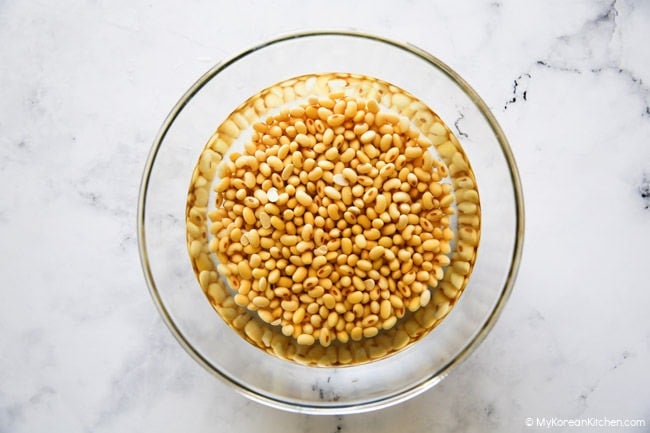
(2) Drain the water and wash the soybeans under running water. Remove any loose shells that come off.
(3) In a pot, mix soybeans with water and 1/4 teaspoon of salt. Boil over medium heat for 15 minutes, skimming off any foam with a spoon. Note: The next three photos show chickpeas.
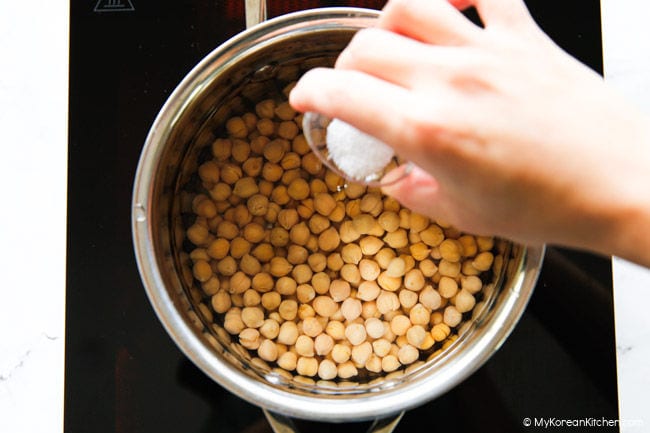
(4) Reduce the heat to medium-low and boil for another 40-45 minutes until the soybeans are fully cooked.
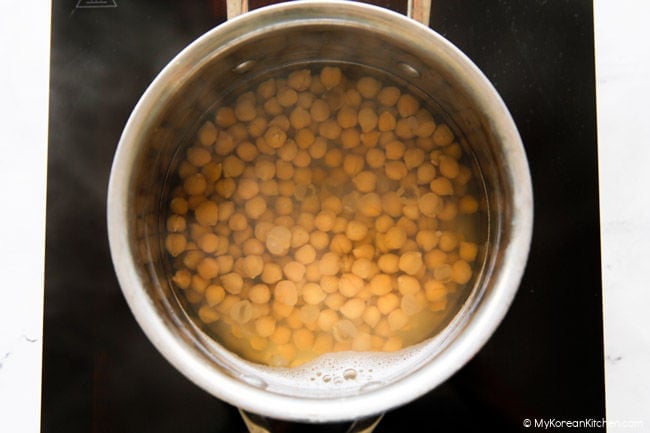
(5) Rinse the soybeans under running water and remove any remaining shells. Set them aside. 1/2 cup (96g / 3.4 ounces) of dry soybeans will yield approximately 1 cup (183g / 6.5 ounces) after boiling.
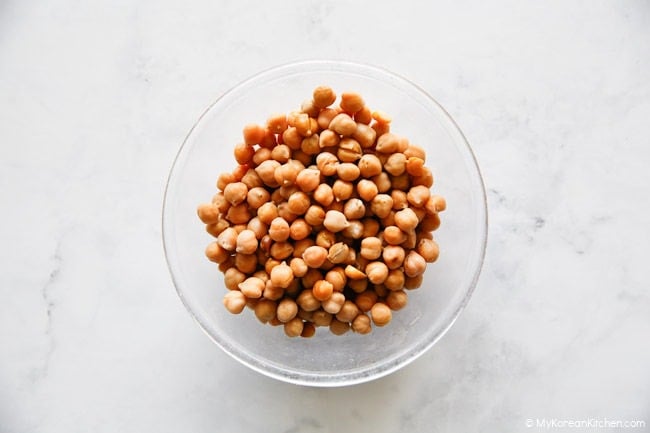
While the soybeans are boiling, use this time to get the other ingredients ready.
2. With a mortar and pestle, crush the sesame seeds, pine nuts, and walnuts until they’re finely ground. This hands-on method is key for a smooth texture since these nuts and seeds don’t blend well in a blender, helping them mix perfectly into the soup.

3. Cook the somen noodles in boiling water according to the package instructions, typically for 3-5 minutes. Once cooked, drain the noodles and rinse them under cold running water to cool.

4. Place the prepared soybeans, soy milk, ground nut mixture from step 2, sugar, and 1/2 teaspoon of salt into a blender. Blend everything together until the mixture is smooth and well combined.
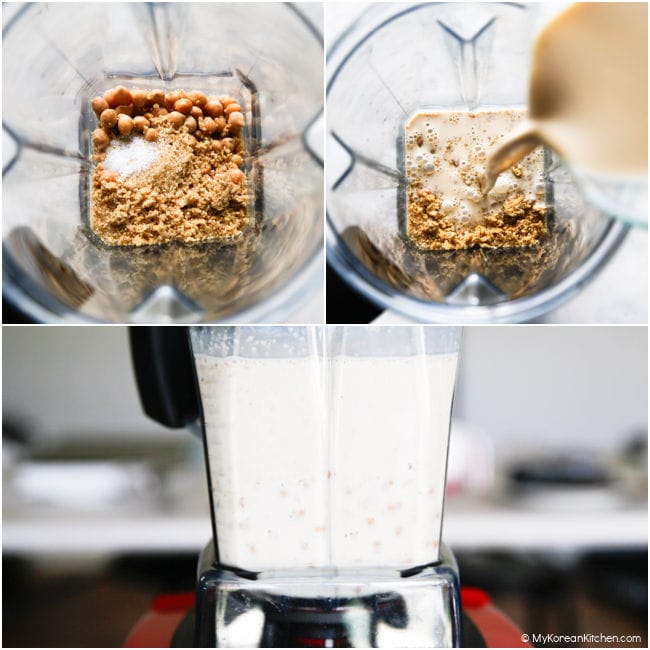
5. Transfer the cooked somen to a serving bowl and pour the soy milk mixture generously over the noodles. Garnish with cucumber slices, cherry tomatoes, and a halved boiled egg.

6. Serve the noodles with some kimchi. Summer varieties like cucumber kimchi or young radish kimchi complement the dish beautifully.
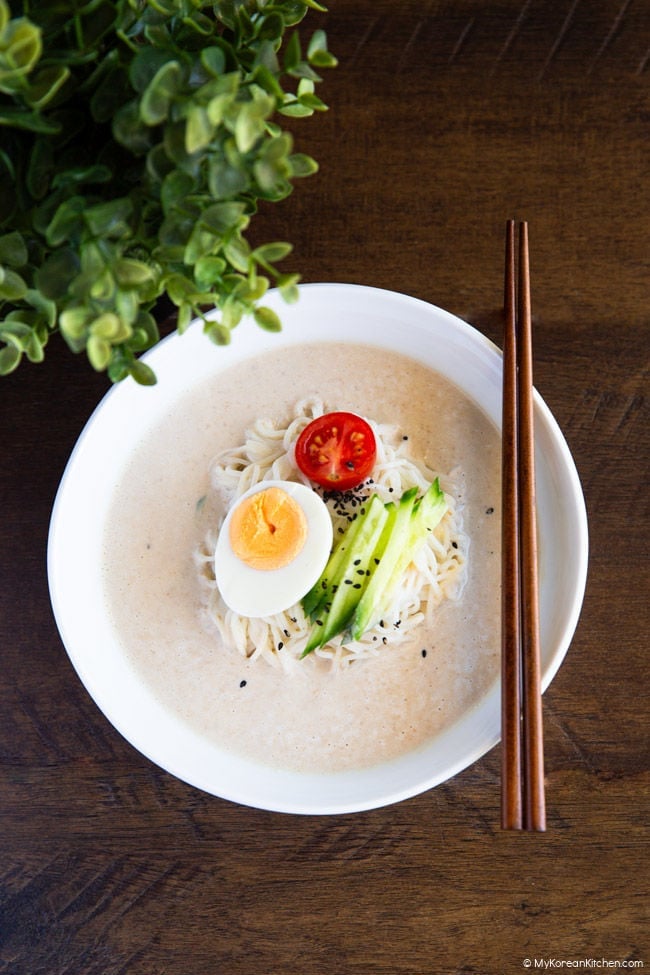
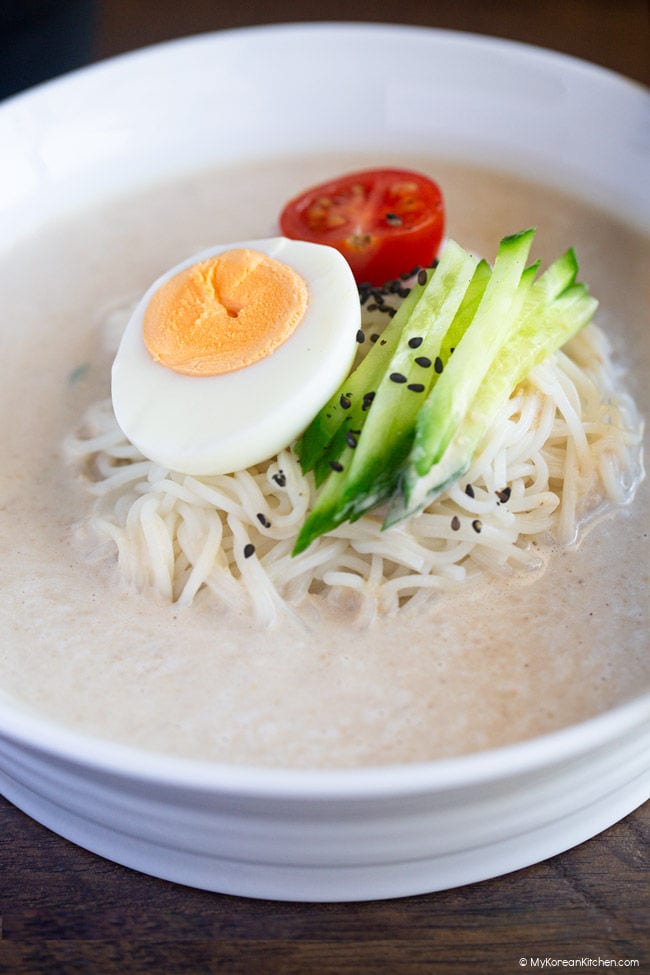
Explore More Cold Korean Noodle Recipes You’ll Love
These dishes offer a refreshing twist with their vibrant flavors and cooling ingredients—just perfect for summertime!
- Bibim Naengmyeon (Korean Spicy Cold Noodles)
- Mul Naengmyeon (Cold Noodle Soup)
- Perilla Oil Noodles
- Cold Kimchi Noodles
Love Korean food? Explore our site for more authentic Korean recipes including how to create a perfect Korean BBQ at home or other easy Korean recipes. Also, never miss a new recipe by subscribing to our newsletter, and join us in celebrating Korean cuisine!
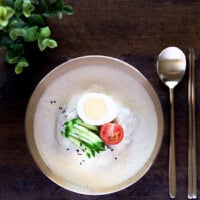
Kongguksu (Soy Milk Noodle Soup)
Ingredients
- 1/2 cup organic dried soybeans (or dried chickpeas, or one 425g can of chickpeas)
- 5 cups water
- 3/4 tsp fine sea salt , divided (1/4 tsp for boiling + 1/2 tsp for blending)
- 1 Tbsp sesame seeds
- 1 Tbsp pine nuts
- 1 Tbsp walnuts
- 200 g somen noodles (thin wheat noodles). (7.1 ounces)
- 2 cups soy milk unsweetened and chilled
- 1 tsp sugar , raw
- 50 g cucumber (Lebanese or English), julienned, (1.8 ounces)
- 1 to 2 cherry tomatoes , halved
- 1 to 2 eggs , boiled and halved
Instructions
Prepare soybeans.
- Soak the dry soybeans in some boiled water (100°C / 212°F) for an hour. Alternatively, you can let them sit in room temperature water overnight, or for at least 6-8 hours.
- Drain the water and wash the soybeans under running water. Remove any loose shells that come off.
- In a pot, mix soybeans with water and 1/4 teaspoon of salt. Boil over medium heat for 15 minutes, skimming off any foam with a spoon. Note: The next three photos show chickpeas.
- Reduce the heat to medium-low and boil for another 40-45 minutes until the soybeans are fully cooked.
- Rinse the soybeans under running water and remove any remaining shells. Set them aside. 1/2 cup (96g / 3.4 ounces) of dry soybeans will yield approximately 1 cup (183g / 6.5 ounces) after boiling.
Get the other ingredients ready.
- With a mortar and pestle, crush the sesame seeds, pine nuts, and walnuts until they’re finely ground. This hands-on method is key for a smooth texture since these nuts and seeds don’t blend well in a blender, helping them mix perfectly into the soup.
- Cook the somen noodles in boiling water according to the package instructions, typically for 3-5 minutes. Once cooked, drain the noodles and rinse them under cold running water to cool.
- Place the prepared soybeans, soy milk, ground nut mixture from step 2, sugar, and 1/2 teaspoon of salt into a blender. Blend everything together until the mixture is smooth and well combined.
- Transfer the cooked somen to a serving bowl and pour the soy milk mixture generously over the noodles. Garnish with cucumber slices, cherry tomatoes, and a halved boiled egg.
- Serve the noodles with some kimchi. Summer varieties like cucumber kimchi or young radish kimchi complement the dish beautifully.
Notes
- 1 Tbsp = 15 ml, 1 Cup = 250 ml
- If you have soybean powder (available at some Korean grocers), mix 1/2 cup with 1 cup of full cream milk and 1/4 teaspoon of fine sea salt to create a soy milk soup. This will make enough for two servings. Next, boil the somen noodles as described in step 3, and serve them with your choice of garnish, like cucumber, cherry tomatoes, and boiled eggs.
Nutrition Info (per serving)
The nutrition information shown is an estimate provided by an online nutrition calculator. It should not be considered a substitute for a professional nutritionist’s advice.
